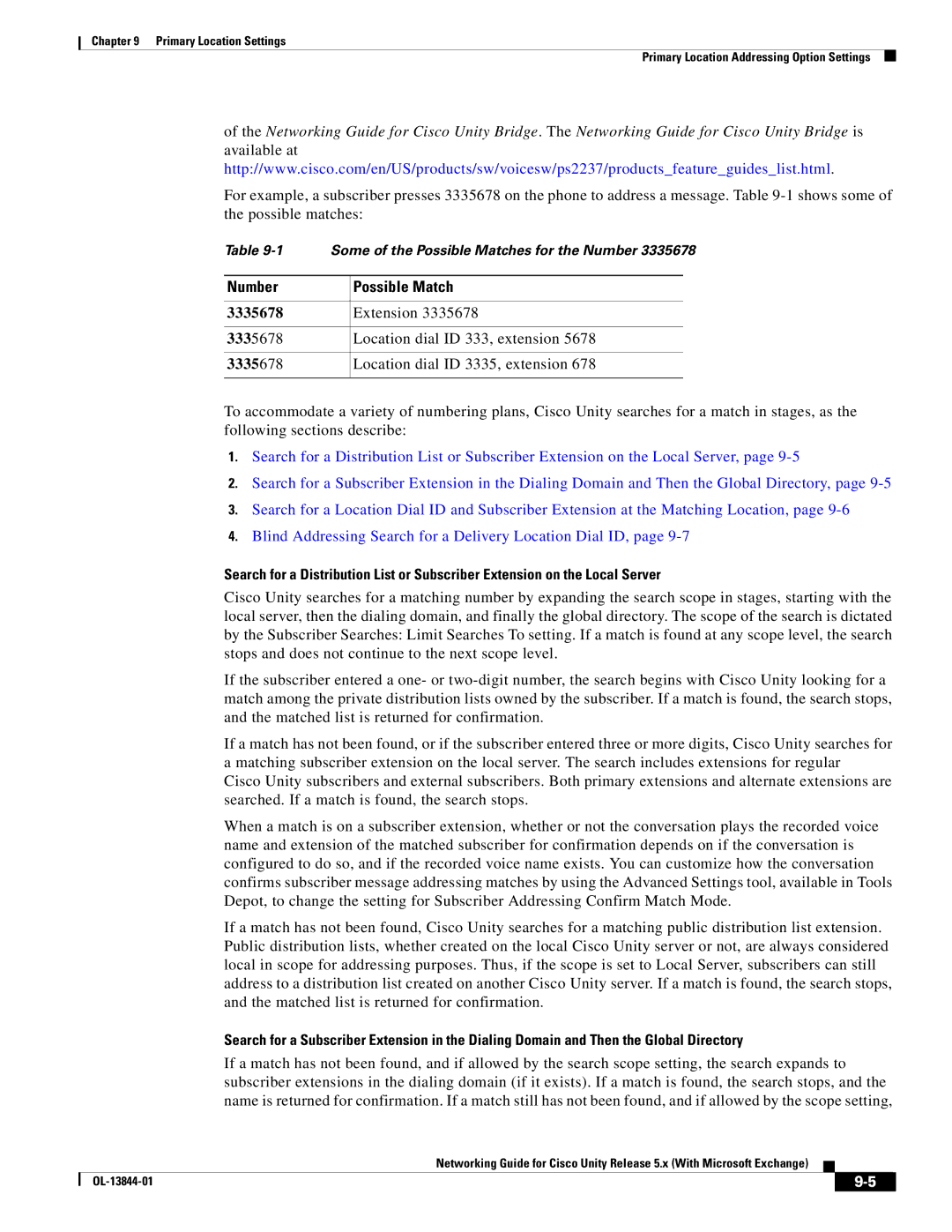
Chapter 9 Primary Location Settings
Primary Location Addressing Option Settings
of the Networking Guide for Cisco Unity Bridge. The Networking Guide for Cisco Unity Bridge is available at http://www.cisco.com/en/US/products/sw/voicesw/ps2237/products_feature_guides_list.html.
For example, a subscriber presses 3335678 on the phone to address a message. Table
Table | Some of the Possible Matches for the Number 3335678 | ||
|
|
|
|
Number |
| Possible Match | |
|
|
|
|
3335678 |
| Extension 3335678 | |
|
|
|
|
3335678 |
| Location dial ID 333, extension 5678 | |
|
|
|
|
3335678 |
| Location dial ID 3335, extension 678 | |
|
|
|
|
To accommodate a variety of numbering plans, Cisco Unity searches for a match in stages, as the following sections describe:
1.Search for a Distribution List or Subscriber Extension on the Local Server, page
2.Search for a Subscriber Extension in the Dialing Domain and Then the Global Directory, page
3.Search for a Location Dial ID and Subscriber Extension at the Matching Location, page
4.Blind Addressing Search for a Delivery Location Dial ID, page
Search for a Distribution List or Subscriber Extension on the Local Server
Cisco Unity searches for a matching number by expanding the search scope in stages, starting with the local server, then the dialing domain, and finally the global directory. The scope of the search is dictated by the Subscriber Searches: Limit Searches To setting. If a match is found at any scope level, the search stops and does not continue to the next scope level.
If the subscriber entered a one- or
If a match has not been found, or if the subscriber entered three or more digits, Cisco Unity searches for a matching subscriber extension on the local server. The search includes extensions for regular Cisco Unity subscribers and external subscribers. Both primary extensions and alternate extensions are searched. If a match is found, the search stops.
When a match is on a subscriber extension, whether or not the conversation plays the recorded voice name and extension of the matched subscriber for confirmation depends on if the conversation is configured to do so, and if the recorded voice name exists. You can customize how the conversation confirms subscriber message addressing matches by using the Advanced Settings tool, available in Tools Depot, to change the setting for Subscriber Addressing Confirm Match Mode.
If a match has not been found, Cisco Unity searches for a matching public distribution list extension. Public distribution lists, whether created on the local Cisco Unity server or not, are always considered local in scope for addressing purposes. Thus, if the scope is set to Local Server, subscribers can still address to a distribution list created on another Cisco Unity server. If a match is found, the search stops, and the matched list is returned for confirmation.
Search for a Subscriber Extension in the Dialing Domain and Then the Global Directory
If a match has not been found, and if allowed by the search scope setting, the search expands to subscriber extensions in the dialing domain (if it exists). If a match is found, the search stops, and the name is returned for confirmation. If a match still has not been found, and if allowed by the scope setting,
Networking Guide for Cisco Unity Release 5.x (With Microsoft Exchange)
|
|
| |
|
|
